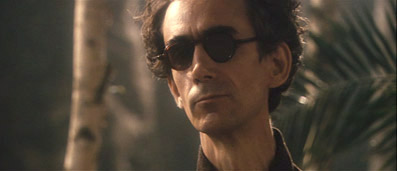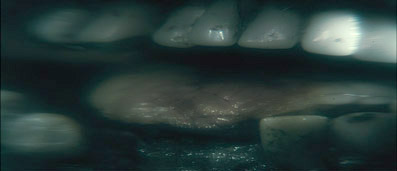| "These things never happen but are always." |
| Sallust |
There
can be no fan anywhere of the cinema of the unusual who
would not be instantly intrigued by a title like The PianoTuner
of EarthQuakes (this arrangement of the words and
letters is correct). It has an almost random, cut-up quality
that suggests a work that will at the very least flirt with
the abstract. Knowing that is was made by The Brothers Quay,
two of the most strikingly original of modern animators,
only adds to the appeal, and for those familiar with their
previous work it creates very specific expectations. The exact
nature of these expectations will depend in part on whether
you coming to the film via the Brothers' first venture into
feature filmmaking, Institute Benjamenta, or This
Dream People Call Human Life. If you bypassed this
and arrive directly from their animated shorts, you might not
get what you expect.
The
film opens in a darkened theatre, where beautiful opera
singer Malvina van Stille has the serious hots for her composer
Adolfo. But shortly into her performance she collapses and
is pronounced dead by the imposing Dr. Emmanuel Droz, who
instantly transports her body from the scene. Some time
later she is revived on Droz's island with only a scant
memory of her life as it was. As Droz prepares her for a
very special performance of his own devising, a skilled
piano tuner named Filesberto Fernandez, who is the double
of Malvina's lost love, arrives on the island. Invited by
Droz, he is asked to repair and fine tune a series of strange
automata. He accepts the task, but becomes increasingly
distracted by the haunting voice he hears singing at night.

The
term 'dreamlike' is bandied about quite a bit, especially
on this site (can't help it, I like those sort of movies),
but if anybody's films deserve the label it's those of the
Brothers Quay.* Their extraordinary animated shorts – Street
of Crocodiles (1986), Rehearsals for Extinct
Anatomies (1988) and The Comb
(1990) are prime examples – evoke a vivid sense of childhood
nightmare and boast some of the most haunting imagery in
modern animation. Their first feature surprised the hell
out of me by being a largely live action piece, but its
twisted reality and consistently gorgeous imagery
was still recognisably the work of the Brothers. The difficulty
for many was that the story was a little slight for a feature-length
film and that is presentation occasionally bordered on
the obscure. If you were of this view, then The
PianoTuner of EarthQuakes is going to provide you
with a few problems. You wouldn't be the only one – I've
been surprised at just how negative much of the reaction
to the film has been, the view being summed up concisely
by the IMDB contributor who suggested that it was "beautiful
to look at, difficult to enjoy." An interesting remark
can be found in Philip French's review in The Observer,
in which he suggests that "Those who like the film
will be few, but they'll probably like it very much."
That sounds like my cue.
As
with Benjamenta, the strangeness of the
location and its inhabitants is viewed primarily through
the eyes of an outsider and communicated in part by his narrated
thoughts. It has to be said
that this element is less effective than it was in the earlier film, too often re-stating what has already been made visually
evident rather than expanding on it. Some narrative and
character elements have also been recycled here,
the identically dressed gardeners and their ritualistic
behaviour recalling Benjamenta's glum students,
while Filesberto's night-time excursions, be they dreams or
investigations, are similar to those undertaken by the curious
Jakob in the earlier film.
Once
again, the film has the feel of a dark fairy tale touched
with gothic, beautifully realised through Nic Knowland's
colour scope cinematography, Larry Sider's layered sound
work, and the Quays' typically evocative production design,
but again story almost always takes a back seat to atmosphere
and suggestion, which is where the audience divide will
set in. Now I can see both sides of the argument here. Plot
development is leisurely at best, drifting from scene to
scene in determinedly unhurried fashion, with characters
carefully sketched rather than explored in any depth. But
intermittently, the sometimes other-worldly melding of sound
and imagery, of the abstract and the poetic, render this
largely irrelevant. The opening ten minutes are a prime
example, with Malvina's collapse and later revival in
a cave dominated by an airborne whirlpool unfolding in hypnotic
and unsettling fashion – if anything, it's the dialogue
scenes that break the spell (the exception being Dr. Droz's
ant story, which is somewhat literally realised later in
the film).

At
its least effective, the film occasionally comes close to
stalling, but its best moments are startling in their originality
and realisation. The various automata provide an opportunity
for the Quays to integrate live action with their unique
brand of animation, while the use of blue screen and reversed
imagery give rise to a hauntingly realised sequence in
which the gardeners move backwards through the woodland
like animated mannequins. It's as vivid a realisation of
dream imagery as I've seen all year.
Despite
the emphasis on the surface detail of the characters rather
than what lies beneath, the roles are all effectively cast.
César Saracho's angular face and hesitant motions
lend Filesberto an undeniably enigmatic quality, while Gottfried
John (who played the Herr Benjamenta in the Quays' previous
feature) nicely underplays the role of Dr. Droz, suggesting
his power and obsession without ever slipping into melodrama.
In an essentially supporting role, Assumpta Serna's smiling
but faltering sexual confidence as Droz's assistant and
(possibly ex-) lover comes the closest to suggesting a back-story
of any real significance.
But
it's the sound and the imagery, with its ability to both delight
the senses and disturb the intellect, that stays with you
and ultimately makes the film so intriguing: the sequences
in which Malvina wraps a band around her knee or seems to
have lost control of one of her hands; the distorted, semi-abstract
close-ups of the mechanical workings of the automata; the
stuttering dream involving a door whose handle suddenly
sprouts spikes when approached. Best of all are the automata
themselves, mechanical embodiments of the surrealist ethos,
mismatching objects in deliciously creepy manner,
from the grotesque, wood-seated mouth that is all teeth
and tongue to the rowing boat operated by two disembodied
porcelain hands. The machines also provide an almost throwaway
moment that delivers one of the film's most intriguing questions
– if you were robbed of your reflection, how, armed only
with a cut-throat razor, would you shave?
It's
a sign of how good video to film transfers are getting that
despite having first seen the film in the cinema (front
row, centre, as ever), it was not until I watched the extras
on this DVD that I realised that the film was shot on hi-def
digital video rather than 35mm. The decision was a practical
one – the Quays have for three years been creating animation
using digital cameras rather than film, and figured it would
be easier to shoot on one format rather than try to match
one to the other. Well it looked good on the big screen
and it looks every bit as good here, especially considering
how dimly some of the scenes are lit and graded. Detail
is very good and sharpness impressive for the most part
– some shots and sequences have a slight and deliberate
softness to them. Black levels appear to be bang-on and
contrast is very good – the bit rate on the transfer is
consistently high.

Dolby
2.0 stereo and 5.1 surround tracks are available, and good
through the stereo is good the surround track is definitely
the way to go. This track is very crisp and clear, with
reasonable separation and some strong subwoofer work when
bass notes are used in the sound effects or music (especially
at the climax).
The
menus, by the way, are very nicely in-keeping with the film
and its principal setting.
An
Interview with The Quay Brothers and scenarist Alan Passes
(49:13) finds the Brothers chattier than I've ever seen
them, openly discussing their early life and their move
from art to film, the challenge of working with actors rather
than puppets, shooting and post-producing on digital, the
music score, and the structure and nature of the film itself.
They also react to the level of criticism that has
been aimed at the film, which appears to have caught them
completely by surprise. Particularly interesting is the
information provided on the genesis of PianoTuner,
with Channel 4 imposing a series of conditions on possible
funding, including that it be more accessible than Benjamenta,
be of a more definable genre, that there would be dialogue
rather than just monologues, and that it be in colour. Alan Passes
chips in well when appropriate, such as the discussion on
creating the script, though he also has a few things to
say about negative audience and critical reaction to the
film. The odd bit of behind-the-scenes footage plays over
the interview, and is of interest.
The
Theatrical Trailer (1:08) is
anamorphic and scope and interesting for including some
of the more adult-orientated (symbolic) imagery, if only
briefly.
The
Unused sequence: "Droz's Secret Flesh"
(2:11) is in a variety of (non-anamorphic) ratios. Out of
context with the scenes that would have surrounded it, it
adds little to the film.
Image
Gallery includes 17 stills from film. They
are about half the screen size and look suspiciously like
frame grabs.
The
Quay Brothers Biography is very brief and
includes a filmography.
Although
it was never destined to find a wide audience, I was and
remain still surprised at the amount of negative reaction
to the Quay Brothers' second feature. It is partly due to
this, I suspect, that our cinema screening did not attract
a larger audience (we did OK, but...). Those who did attend
reacted very favourably to what they'd seen – a friend of
mine approached me quoting influences I hadn't even picked
up on, from John Fowles to Svengali to The Tales
of Hoffman, adding "I really enjoyed that.
Very nice." Screenwriter Alan Passes suggests that
the film benefits from multiple viewing and I would certainly
agree with that. It's not a dazzler, at least as a whole,
but there is a lot to admire and enjoy here, and I can't
help feeling that too many are watching the film without really seeing it.
Artificial
Eye's DVD looks and sounds good, and benefits from probably
the most detailed interview I've yet seen with the Quays.
If you already know and like the film then there are no
problems here. If not then I'd definitely suggest giving
it a chance. Remember Philip French's words – you might
well find yourself one of the few who like it a lot.
* In the interview on this disc the Brothers
suggest that the term 'dreamlike' is all wrong for
this film. Sorry guys, but it works for me...
|